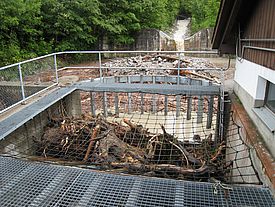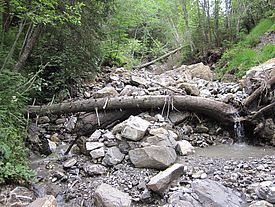Driftwood in a mountain torrent carries significantly more carbon downstream than previously thought, according to a study by Jens Turowski from the Swiss Federal Institute for Forest, Snow and Landscape Research WSL and his colleagues. They believe that coarse plant particles must be taken into consideration when analyzing the carbon balance. The study is published in Geology.
When rivers carry driftwood downhill, apart from dispersing nutrients, they may also help in long-term removal of carbon dioxide (CO2) from the atmosphere. Plants 'breathe' in CO2 and convert it into organic matter. When this matter is deposited in a low-oxygen environment in river and ocean sediments, the CO2 is removed from the global carbon cycle for a very long time and cannot contribute to climate change.
Mountain streams can carry huge quantities of plant matter. Scientists have therefore long been measuring the carbon content in water samples from streams. However, little is currently known about the amount of larger pieces such as tree trunks, branches or leaves, as they are complicated to measure.
80% of total carbon
Turowski's team from the WSL's Mountain Torrents Group has made up for this at the Erlenbach in Alpthal (Canton of Schwyz, Switzerland). Based on data extrapolated from the last three decades, plant particles bigger than 1 mm account for a third of the stream's total carbon transport. This number rises to as much as 80% when four large flood events in the study period are included. "You cannot ignore this coarse organic material," stressed Turowski, who now works at the German Research Centre for Geosciences (GFZ) in Potsdam.
The researchers showed for the first time that driftwood dominates carbon transport at the start of the transport chain. They also demonstrated that coarse plant particles still account for around 10% of all carbon in a sediment deposit in Italy, accumulated approximately 14 million years ago about 300 km off the coast. However, what happens on the way from the mountain stream to the ocean is largely unknown.
The Erlenbach is one of the best observed streams in the world as far as the transport of bedload, i.e. gravel and pebbles, is concerned. Since 1986, WSL researchers have been measuring the stream's load continuously with acoustic sensors and recently also with an automated bedload collection system, hauling out stones, pebbles and larger driftwood in baskets.
This made it easy for Turowski to separate plant material from rubble. To measure the floating particles at low water flow rates, the team immersed a fishing net fixed onto a metal frame in the stream. They dimensioned the really large fragments after each flood event.
Ten times more carbon than estimated
The researchers examined for all the fragments whether they floated on the water or were so saturated with water that they sank to the bottom. Wood dragging along the riverbed is ground down by hard stones, explained Turowski. "This could be an essential source of fine organic material that originates in the river itself." He added that hardly anything is currently known about the attrition of organic material when transported by water.
Thanks to the long data series on the Erlenbach, Turowski and his colleagues from the British universities of Durham and Cambridge were able to calculate the driftwood quantities for the last 30 years. "The amount of carbon we collected is about 2.5 times bigger than experts previously assumed," said Turowski. "It’s even ten times bigger if we include extreme flood events or storms." Floods could become more frequent with climate change. Turowski believes that these results are representative for other mountain torrents.
He concludes that "our existing estimates overlook the majority of carbon floating down rivers." He strongly believes that plant particles entrained in streams and rivers should to be incorporated into regional and global carbon analyses.
Contact
Jens Turowski, Deutsches GeoForschungsZentrum GFZ, Potsdam
Tel: +49 331 288-28762
E-Mail: jens.turowski(at)gfz-potsdam.de
Copyright
Copyright
WSL and SLF provide the artwork for imaging of press articles relating to this media release for free. Transferring and saving the images in image databases and saving of images by third parties is not allowed.
Links and documents
Publication:
Jens M. Turowski, Robert G. Hilton, and Robert Sparkes: "Decadal carbon discharge by a mountain stream is dominated by coarse organic matter", Geology, first published on November 20, 2015, doi:10.1130/G37192.1

